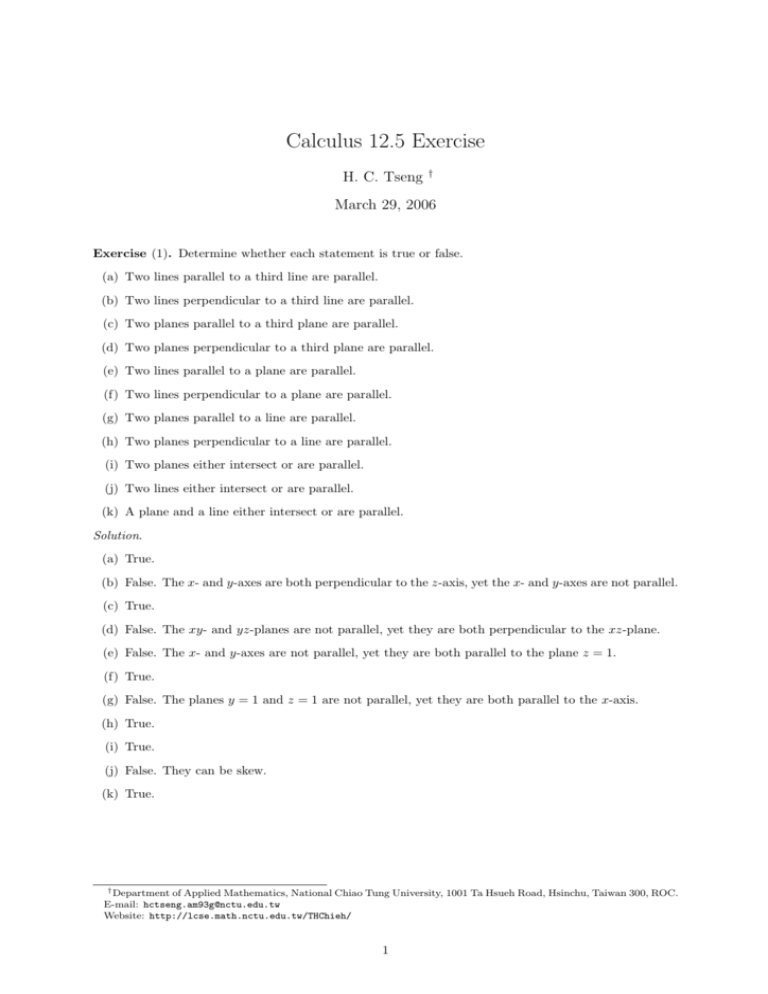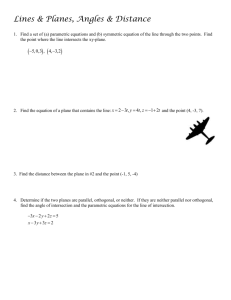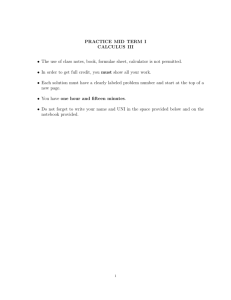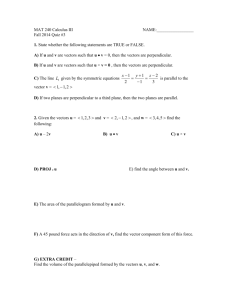Calculus 12.5 Exercise
advertisement

Calculus 12.5 Exercise H. C. Tseng † March 29, 2006 Exercise (1). Determine whether each statement is true or false. (a) Two lines parallel to a third line are parallel. (b) Two lines perpendicular to a third line are parallel. (c) Two planes parallel to a third plane are parallel. (d) Two planes perpendicular to a third plane are parallel. (e) Two lines parallel to a plane are parallel. (f) Two lines perpendicular to a plane are parallel. (g) Two planes parallel to a line are parallel. (h) Two planes perpendicular to a line are parallel. (i) Two planes either intersect or are parallel. (j) Two lines either intersect or are parallel. (k) A plane and a line either intersect or are parallel. Solution. (a) True. (b) False. The x- and y-axes are both perpendicular to the z-axis, yet the x- and y-axes are not parallel. (c) True. (d) False. The xy- and yz-planes are not parallel, yet they are both perpendicular to the xz-plane. (e) False. The x- and y-axes are not parallel, yet they are both parallel to the plane z = 1. (f) True. (g) False. The planes y = 1 and z = 1 are not parallel, yet they are both parallel to the x-axis. (h) True. (i) True. (j) False. They can be skew. (k) True. † Department of Applied Mathematics, National Chiao Tung University, 1001 Ta Hsueh Road, Hsinchu, Taiwan 300, ROC. E-mail: hctseng.am93g@nctu.edu.tw Website: http://lcse.math.nctu.edu.tw/THChieh/ 1 Find a vector equation and parametric equations for the line. Exercise (5). The line through the point (1, 0, 6) and perpendicular to the plane x + 3y + z = 5. Solution. A line perpendicular to the given plane has the same direction as a normal vector to the plane, such as n = (1, 3, 1). So, a vector equation is r = (1 + t)i + 3tj + (6 + t)k and a parametric equation is x = 1 + t, y = 3t, z = 6 + t. Find parametric equations and symmetric equations for the line. Exercise (11). The line through (1, −1, 1) and parallel to the line x + 2 = 12 y = z − 3. Solution. The line has direction v = (1, 2, 1). A parametric equation is x = 1 + t, y = −1 + 2t, and a symmetric equation is x−1= z =1+t y+1 = z − 1. 2 Exercise (15). (a) Find symmetric equations for the line that passes through the point (0, 2, −1) and is parallel to the line with parametric equations x = 1 + 2t, y = 3t, z = 5 − 7t. (b) Find the points in which the required line in part (a) intersects the coordinate planes. Solution. (a) A direction vector of the line is v = (2, 3, −7). Here P0 = (0, 2, −1), so symmetric equations for the line are x y−2 z+1 = = . 2 3 −7 −2 11 (b) The line intersects the¡ plane when ¢ z = 0, so we need x = 7 , y = 7 . Thus the point of intersection −2 11 with the ¡zy-plane ¢is 7 , 7 , 0 . Similarly for the yz-plane, we have (0, 2, −1). For the xz-plane, 11 we have −4 3 , 0, 3 . Determine whether the lines L1 and L2 are parallel, skew, or intersecting. If they intersect, find the point of intersection. Exercise (19). L1 : x = −6t, y = 1 + 9t, z = −3t L2 : x = 1 + 2s, y = 4 − 3s, z = s Solution. Since the direction vectors are v1 = (−6, 9, −3) and v2 = (2, −3, 1), we have so the lines are parallel. Find an equation of the plane. Exercise (29). The plane through the point (4, −2, 3) and parallel to the plane 3x − 7z = 12. Solution. Since the two planes are parallel, they will have the same normal vectors. So we can take n = (3, 0, −7), and an equation of the plane is 3(x − 4) + 0[y − (−2)] − 7(z − 3) = 0 or 3x − 7z = −9. Exercise (37). The plane that passes through the point (−1, 2, 1) and contains the line of intersection of the planes x + y − z = 2 and 2x − y + 3z = 1. 2 Solution. A direction vector for the line of intersection is a = n1 × n2 = (1, 1, −1) × (2, −1, 3) = (2, −5, −3), and a is parallel to the desired plane. Another vector parallel to the plane is the vector connecting any point on the line of intersection - for example, (0, 27 , 32 ) - to the given point (−1, 2, 1) in the plane. So we have another vector (−1, − 23 , − 12 ) which is parallel to the plane. Then a normal vector to the plane is 3 1 n = (2, −5, −3) × (−1, − , − ) = (−2, 4, −8) 2 2 and an equation of the plane is −2(x + 1) + 4(y − 2) − 8(z − 1) = 0 or x − 2y + 4z = −1. Find the point at which the line intersects the given plane. Exercise (41). x = y − 1 = 2z; 4x − y + 3z = 8 Solution. Parametric equations for the line are x = t, y = 1 + t, z= 1 t. 2 Substituting it into the equation of the plane, we have t = 2. Thus, the point of intersection is (2, 3, 1). Determine whether the planes are parallel, perpendicular, or neither. If neither, find the angle between them. Exercise (49). x = 4y − 2z, 8y = 1 + 2x + 4z Solution. The normals are n1 = (1, −4, 2) and n2 = (2, −8, 4). Since n2 = 2n1 , the normals, and thus the planes, are parallel. Exercise (59). Find parametric equations for the line through the point (0, 1, 2) that is parallel to the plane x + y + z = 2 and perpendicular to the line x = 1 + t, y = 1 − t, z = 2t. Solution. Two vectors which are perpendicular to the required line are the normal of the given plane, (1, 1, 1), and a direction vector for the given line, (1, −1, 2). So a direction vector for the required line is v = (1, 1, 1) × (1, −1, 2) = (3, −1, −2). Thus L is given by x = 3t, y = 1 − t, z = 2 − 2t. Use the formula in Exercise 39 in Section 12.4 to find the distance from the point to a given line. Exercise (63). (1, 2, 3); x = 2 + t, y = 2 − 3t, z = 5t Solution. Let Q = (2, 2, 0) and R = (3, −1, 5), points on the line corresponding to t = 0 and t = 1. Let −−→ −−→ P = (1, 2, 3) and a = QR = (1, −3, 5), b = QP = (−1, 0, 3). The distance is |a × b| |(1, −3, 5) × (−1, 0, 3)| |(−9, −8, −3)| = = |a| |(1, −3, 5)| |(1, −3, 5)| r p √ 2 2 2 (−9) + (−8) + (−3) 154 22 p = √ = = 2 2 2 5 35 1 + (−3) + 5 d= Find the distance between the given parallel planes. Exercise (67). z = x + 2y + 1, 3x + 6y − 3z = 4 Solution. Put y = z = 0 in the equation of the first plane to get the point (−1, 0, 0) on the plane. Because the planes are parallel, the distance d between them is the distance from (−1, 0, 0) to the second plane. By Equation 9, √ 7 7 6 |3(−1) + 6(0) − 3(0) − 4| p = √ = . d= 18 3 6 32 + 62 + (−3)2 3









